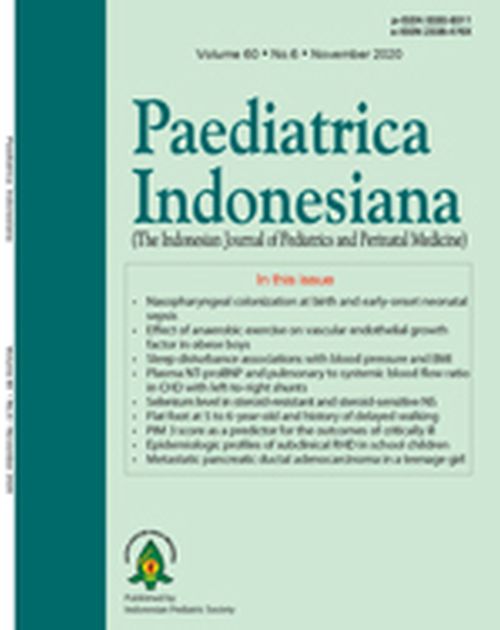Epidemiologic profiles of subclinical rheumatic heart disease in children
DOI:
https://doi.org/10.14238/pi60.6.2020.334-40Keywords:
RHD; subclinical RHD; echocardiograpy; risk factor; school childrenAbstract
Background Rheumatic heart disease (RHD) causes premature deaths every year worldwide. Low socioeconomic level is considered to be a risk factor facilitating the transmission of airway infections due to Streptococcus pyogenes. Subclinical RHD is a stage of RHD in which heart valve abnormalities have occurred according to the WHO or WHF classification but without any complaints to the subject. Echocardiography is used to screen subclinical RHD in several countries.
Objective To estimate the prevalence, risk factors, and echocardiographic features of subclinical RHD in children.
Methods This cross-sectional study was conducted on 250 elementary school children in Palembang, South Sumatera. We interviewed subject's parents about family characteristics, environment, and history of recurrent sore throat. Subjects underwent anthropometric examination, auscultation, and echocardiography. Diagnosis of RHD was based on World Health Organization (WHO) and World Heart Federation (WHF) criteria.
Results Of 250 subjects, 132 (53.8%) were girls. Subjects’ age range was 5-14 years. The prevalence of subclinical RHD was 8% (95%CI 4.8 to 11.6). Of the 20 subclinical RHD subjects, 15 (75%) met the possible RHD criteria, 5 (25%) met the probable RHD criteria, and none met the definite RHD criteria. Multivariate analysis showed that household crowding (OR 8.135; 95%CI 1.048 TO 63.143; P=0.045), history of recurrent sore throat within the previous 6 months (OR 6,476; 95%CI 1.79 to 23.427; P=0.004) and age > 10 years (OR 3.167, 95%CI 1.184 to 8.471; P=0.022) significantly increased the risk of subclinical RHD.
Conclusion The prevalence of subclinical RHD in elementary school children in Palembang was 8%. For echocardiographic features, most cases met the WHO/WHF possible RHD criteria. Factors significantly associated with the incidence of subclinical RHD are age > 10 years, household crowding, and history of recurrent sore throat in the previous 6 months.
References
2. Watkins DA, Johnson CO, Colquhoun SM, Karthikeyan G, Beaton Andrea, Bukhman Gene, et al. Global, regional, and national burden of rheumatic heart disease, 1990-2015. N Engl J Med. 2017;377:713-22.doi: 10.1056/NEJMoa1603693.
3. Shrestha NR, Karki P, Mahto R, Gurung K, Pandey N, Agrawal K, et al. Prevalence of subclinical rheumatic heart disease in Eastern Nepal: a school-based cross-sectional study. JAMA Cardiol.2016;1(1): 89-96. doi: 10.1001/jamacardio.2015.0292.
4. Rahmawaty NK, Burhanuddin I, Husain A, Dasril D. Faktor risiko serangan berulang demam rematik/penyakit jantung rematik. Sari Pediatr.2012;14(3):179-84. doi: http://dx.doi.org/10.14238/sp14.3.2012.179-84.
5. Beaton A, Okello E, Lwabi P, Mondo C, McCarter R, Sable C. Echocardiography screening for rheumatic heart disease in Ugandan schoolchildren. Circulation.2012;125(25):3127-32. doi: 10.1161/CIRCULATIONAHA.112.092312.
6. Reményi B, Wilson N, Steer A, Ferreira B, Kado J, Kumar K, et al. World Heart Federation criteria for echocardiographic diagnosis of rheumatic heart disease an evidence based guideline. Nat Rev Cardiol.2012; 9(5): 297-309. doi:10.1038/nrcardio.2012.7.
7. Saxena A, Ramakrishna S, Roy A, Seth S, Krishnan A, Puneet M, et al. Prevalence and outcome of subclinical rheumatic heart disease in India: the RHEUMATIC (rheumatic heart echo utilisation and monitoring actuarial trends in indian children) study. Heart.2011;97(24):2018-22. doi: 10.1136/heartjnl-2011-300792.
8. Ikatan Akuntansi Indonesia (IAI). Pernyataan standar akuntansi keuangan, Pendapatan. Jakarta: DSAK-IAI; 2012.
9. Kemenkes RI. Persyaratan kesehatan perumahan (Keputusan Menteri Kesehatan RI Nomor 829/MENKES/SK/II/1999). Jakarta: Kemenkes RI; 1999.
10. National Center for Health Statistics, CDC. 2000 CDC growth charts. [cited 2018 October 26]. Available from: https://www.cdc.gov/growthcharts/cdc_charts.htm.
11. Carapetis JP, Paar J, Cherian T. Standardization of epidemiologic protocols for surveillance of post-streptococcal sequelae: acute rheumatic fever, rheumatic heart disease and acute post-streptococcal glomerulone- phritis. National Institute of Allergy and Infectious Diseases. 2006 Jan;1.
12. Rothenbuhler M, O’Sullivan CJ, Stortecky S, Stefanini G, Spitzer E, Estill J, et al. Active surveillance for rheumatic heart disease in endemic regions: a systematic review and meta-analysis of prevalence among children and adolescents. Lancet Glob Health.2014; 2(12): e717-26. doi: 10.1016/S2214-109X(14)70310-9.
13. World Health Organization. Global action plan for the prevention and control of NCDs 2013 -2020. [cited 2018 September 9]. Available from: http://www.who.int/nmh/events/ncd_ action_plan/en.
14. Rahayuningsih SE. Role of demam rematik akut. Presented at Pendidikan ilmu kesehatan anak berkelanjutan (PIKAB) IX; 2011 Okt 1-2; Bandung.
15. Dajani AS. Rheumatic fever. In: Zipes DP, Libby P, Bonow RO, Braunwald E, eds. Braunwald’s heart disease.2007. 7th ed. Philadelphia: Elsevier Saunders. p. 2093-9.
16. Lewis KD, Conway J, Cunningham C, Larsen BMK. Optimizing nutrition in pediatric heart failure: The crisis Is over and now it’s time to feed. Nutr Clin Pract. 2018 Jun;33(3):397-403. doi: 10.1177/0884533617712502.
Downloads
Published
How to Cite
Issue
Section
License
Authors who publish with this journal agree to the following terms:
Authors retain copyright and grant the journal right of first publication with the work simultaneously licensed under a Creative Commons Attribution License that allows others to share the work with an acknowledgement of the work's authorship and initial publication in this journal.
Authors are able to enter into separate, additional contractual arrangements for the non-exclusive distribution of the journal's published version of the work (e.g., post it to an institutional repository or publish it in a book), with an acknowledgement of its initial publication in this journal.
Accepted 2020-11-13
Published 2020-11-13


















